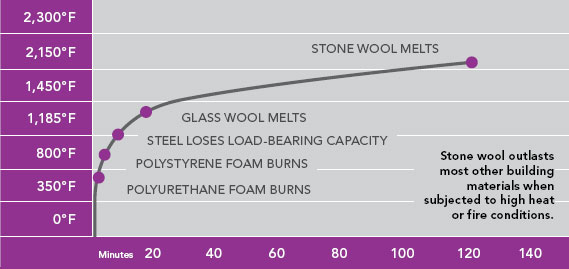The Value of Stone Wool Acoustical Ceilings
In addition to acoustic ceiling panels, stone wool's unique combination of thermal, fire, and acoustic properties make it well suited for blown or batt insulation in cavity walls, board type of insulation for roofing installations, and pre-formed insulation pieces for faced pipe sections and wall slabs.
Once stone wool is formed into the more rigid panels, they move to a curing oven where the final properties are locked in the curing of the binder. Finishing of the ceiling panels relies on the use of a mineral fleece and water-based paint which are layered on top of the stone wool to produce the desired appearance.
Note that since stone wool is naturally porous and sound absorbent, there is no need to create fissures or holes to improve sound qualities. That means that the surface can look more uniform and smoother than many mineral fiber ceiling tiles. The finished panels then proceed on to formatting saws, where they are cut to specific tile sizes, and edge profiling equipment, where final edge profiles are formed. In certain cases, the panels could be diverted to specific custom finishing processes or be led to off-line equipment for special treatment. Once complete, the finished tiles are then gathered and packaged for shipment.
From an environmental standpoint, the off-gases of the production process coming from the furnace, spinning chamber, and curing oven are typically cleaned in filters and after-burners before entering the chimney, helping to assure a rather clean operation. Further, the waste inevitably created during the production is recaptured and reused since it is both fully recyclable and a valuable raw material.
Properties of Stone Wool Ceiling Tiles
Once completed, stone wool acoustic ceiling tiles generally have a density that is higher than fiberglass ceiling tiles, making them more rigid and durable. Additionally, stone wool exhibits a number of other superior properties when compared to other acoustical ceiling tile choices, which are summarized as follows:
Surface burning characteristics. UL 723 (ASTM E84) / CAN / ULC S102 is a standard method of testing for surface burning characteristics of particular building materials. The test is designed to determine the relative surface burning characteristics of materials under specific test conditions. Results are expressed in terms of Flame Spread Index (FSI) and Smoke Developed Index (SDI). Many commercial applications require an FSI of 25 or less and an SDI of 50 or less. Products labeled “FHC 25/50” (Fire Hazard Classification 25/50) or “Class A” (ASTM E1264) fulfill these requirements. Most stone wool ceiling panels in North America outperform the fire requirements for ceilings due to their non-combustible makeup.
Dimensional stability. This term is generally defined as the material's ability to retain its original shape when subjected to external forces such as varying degrees of temperatures, atmospheric pressures, moisture content, and/or other external stresses. Stone wool retains its manufactured characteristics unaltered over time with the particularly unique property of not expanding or contracting when subjected to changing heat or cold conditions. This has been commonly demonstrated using the ASTM C356 test for thermal expansion. For ceiling tiles, that means a tighter fit in the grid and tolerances can be maintained over time without concerns of the tile swelling or shrinking.
Humidity resistance. Humidity can weaken the structure of certain ceiling materials and cause them to sag. In extreme cases they may even fall out of the grid. This will often happen in buildings under construction where the building is not fully sealed, or materials have not dried out.
Additionally, humidity levels are naturally high in wet rooms like kitchens and sanitary areas, where moisture problems can occur. Stone wool is a hydrophobic material, meaning it does not absorb water and is not impacted by humidity. As such, stone wool ceiling panels have been found to be dimensionally stable at up to 100 percent relative humidity. That means that stone wool ceiling panels can be installed in the early stages of construction (when the windows are not fully sealed) without any risk of sagging.

Image courtesy of ROCKFON
Stone wool outlasts most other building materials when subjected to high heat or fire conditions.
Mold and mildew resistance. Stone wool is water repellent and has no nutritional value. Hence, stone wool ceiling panels inhibit growth of mold and bacteria through their inherent material makeup. In healthcare buildings, they have also been shown to provide no sustenance to other harmful micro-organisms.
Impact resistance. High-usage areas can create heavy wear and tear on building materials, thus requiring impact-resistant ceiling panels. This is commonly true in settings like schools and gyms where ceilings in these kinds of areas need to be able to withstand tougher-than-average conditions as well as frequent access requirements. Special, reinforced stone wool ceiling tiles are available to address this need.
All of these properties are significant and important in the design of buildings. However, there is one more important aspect that we will delve more deeply into, namely the acoustical performance of ceilings.









